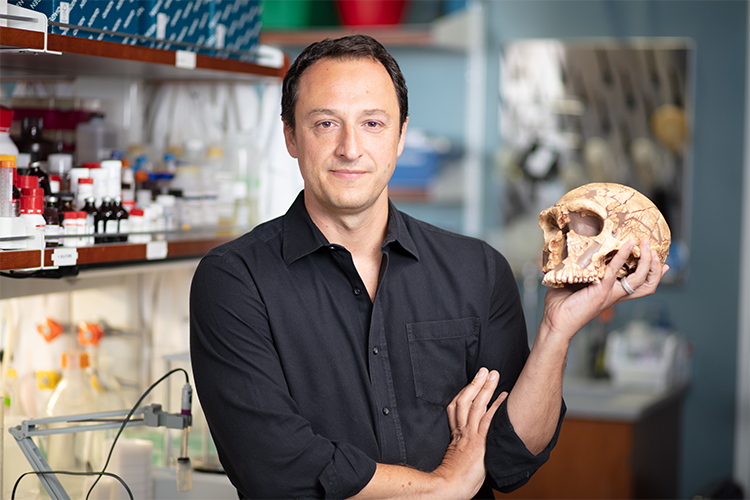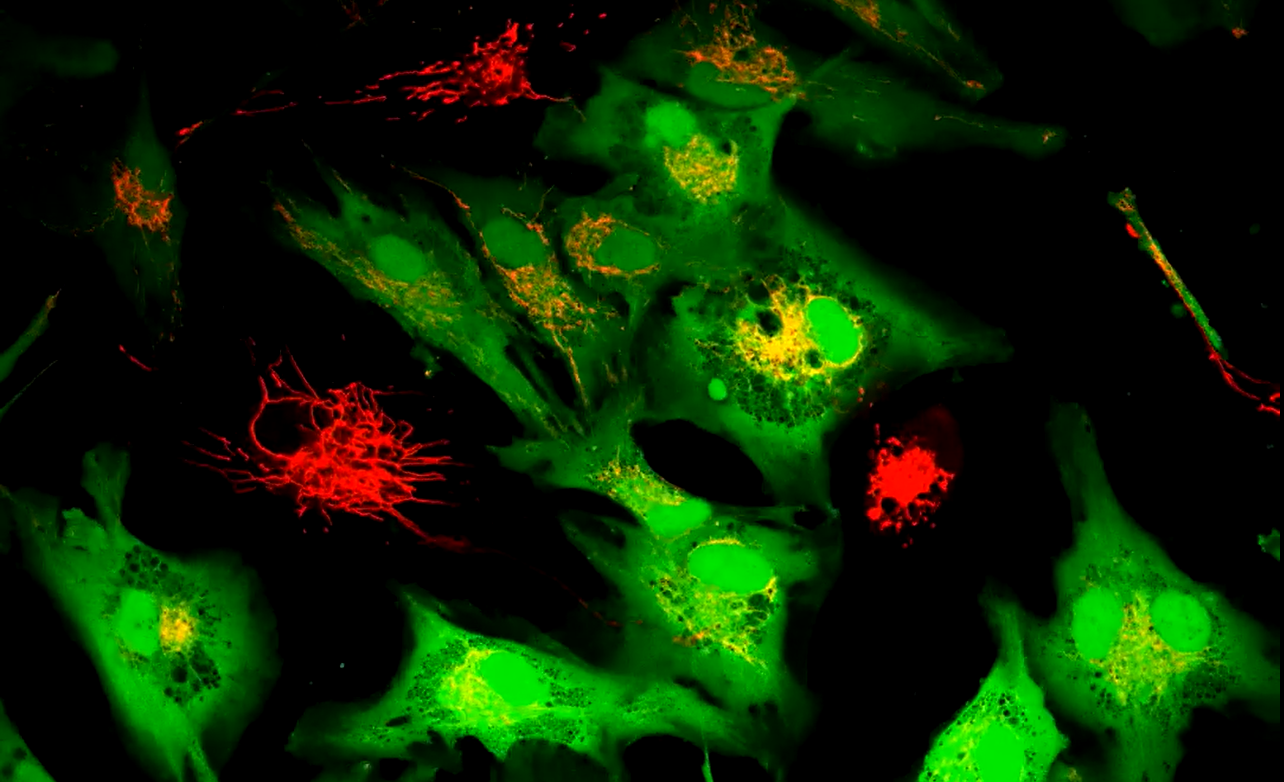Ancient lead exposure may have helped early humans evolve language and intelligence
New research reveals that early humans and their relatives were exposed to toxic lead millions of years ago.

Alysson Muotri, Ph.D. Lead exposure shaped human evolution, influencing brain development and the rise of language. (CREDIT: Kyle Dykes/UC San Diego Health Sciences)
Long before factories, mines, and cars filled the air with pollution, our distant ancestors were already living with a silent toxin: lead.
A groundbreaking study reveals that hominids — from early human ancestors to Neanderthals and extinct great apes — were exposed to lead millions of years prior to the industrial age. That exposure might have done more than damage developing brains; it might have tipped the course of human evolution in an unexpected direction, designing the genetic features that spawned language and social bonding.
Clues Hidden in Ancient Teeth
An international research effort led by scientists at the University of California San Diego School of Medicine examined 51 fossilized teeth from sites across Africa, Asia, and Europe. The teeth, belonging to early humans, Neanderthals, and great apes such as Gigantopithecus blacki, held microscopic evidence of lead exposure — "lead bands" that appeared when the element was introduced during early childhood.
Their results were stark. Nearly three-fourths of all the fossils they tested showed signs of lead pollution, 71% of the teeth of human and archaic humans included. The ones as old as G. blacki, dating to some 1.8 million years ago, showed acute levels of exposure akin to those in the heyday of leaded gasoline consumption in the mid-20th century.
Scientists used to believe that lead poisoning emerged as a human health concern only after we started mining and producing the metal for so long. But these fossils indicate otherwise. "We stopped using lead in daily life as soon as we realized how toxic it is, but nobody had ever looked at lead before prehistoric times," said Dr. Alysson Muotri, study's senior author and a professor of pediatrics and cellular and molecular medicine at UC San Diego. "To our surprise, the same trends we observed in ancient fossils appeared in people born between 1940 and 1970 — the era of leaded gasoline and paint."
Ancient hominids likely encountered lead in natural deposits such as soil, caves, or water flowing through rock with mineral deposits. The danger would have been especially serious for infants, whose developing teeth and brains readily absorbed chemicals from the environment. Lead is an interrupter of neural development, a diminishment of intelligence, and a disruption of mood control — all making it an important evolutionary mechanism for species that lived in contaminated habitats.
A Tiny Mutation That Changed Everything
To understand how humans managed to thrive despite such toxicity, Muotri’s team turned to genetics. They focused on a gene called NOVA1 — short for neuro-oncological ventral antigen 1 — which helps control how brain cells connect and communicate. NOVA1 also regulates how developing neurons respond to environmental stress, including toxins like lead.
Modern humans carry a version of NOVA1 that differs from that of Neanderthals by just a single DNA base pair. It’s a tiny change, but earlier work by Muotri’s group showed it has a dramatic impact. When they replaced the human NOVA1 with the Neanderthal version in miniature brain models called organoids, the result was faster but less complex neural development — a kind of “early bloom” that didn’t last.
"Everything else about the organoids is identical except for that one variant," Muotri said. "If all human beings alive today are harboring this more recent mutation, it must have provided a very strong advantage in our species."
To experiment with that advantage, the researchers grew brain organoids with either the modern or archaic NOVA1 variant and then treated them to lead. Both versions showed changes in gene activity related to neurological disorders such as autism and epilepsy.
But one important difference emerged when they looked at FOXP2 — a gene closely linked with speech and language. With organoids containing the ancient NOVA1 variant, lead significantly disrupted FOXP2 expression and damaged neurons utilized in vocal communication. The new NOVA1 variant, however, shielded those neurons, leaving FOXP2 function comparatively intact.
The FOXP2 gene is identical in us and in the Neanderthals," Muotri said. "The difference lies in how NOVA1 controls it. The archaic one makes the language-involved neurons more vulnerable to being killed by lead."
The Evolutionary Edge of Language
If modern humans carried a mutation protecting brain regions for language from the neurotoxic action of lead, that minor genetic benefit could have shaped human destiny. The ability for speech, teaching, and planning could have given our ancestors a survival, cooperative, and cultural edge — while Neanderthals were suffering from communication issues.
"Language is so much of a plus — it's revolutionary, it's our superpower," Muotri said. "Because we have language, we can organize society and exchange ideas. There's no reason to believe Neanderthals would be able to do that." He speculates that continuous lead exposure even caused them to go extinct around 40,000 years ago.
The study points to the intermeshing of environmental pressures and genetic adaptation. Adverse conditions could have been the impetus for our species to develop protective mechanisms — in this case, a genetic mutation that protected cognitive flexibility and evolved communication in spite of environmental stress.
Lessons Hidden in the Past
Though lead poisoning from industrial sources is a modern legacy, contamination is a persistent worldwide concern. Most locations continue to grapple with high levels of lead in drinking water, lead paint, or soil. The new research is a reminder that the environment continued to test human resilience — and that biology sometimes evolves in unforeseen fashion.
Lead's long history as a neurotoxin also raises profound questions about other environmental stresses that might have molded the human mind. If lead exposure impacted brain development and communication, what might have been the other natural toxins or stresses that might have shaped our evolution?
Muotri thinks that research like this joins anthropology and medicine. "Looking at how NOVA1 controls FOXP2 under environmental stress offers insights not only into evolution, but into contemporary neurological disease," he explained. Conditions like speech apraxia — trouble making sounds — and some types of autism could be caused by the way these genes react to toxins during development.
By looking into the very ancient past, scientists are trying to determine why certain people are more resilient to environmental pollutants than others — and how those differences trace back to our evolutionary past.
Real-World Relevance of the Research
This study gives a glimpse, though uncommon, of the way environmental toxins have shaped human evolution — and how that is relevant to us today. Understanding why genes such as NOVA1 protect the brain may hold new mechanisms to thwart or treat neurological disease linked to environmental stress, from autism to language deficits.
It also highlights the importance of lead removal from homes, water systems, and ground, especially where children are most vulnerable. More broadly, it shows how slight genetic adjustments can enable human endurance to environmental toxins, enabling survival even in hostile environments.
The same endurance that enabled our ancestors to survive could guide modern medicine in protecting the next generation.
Research findings are available online in the journal Science Advances.
Related Stories
- Daily dose of game-like online exercises reverse 10 years of brain aging
- Lead pollution likely caused IQ declines in ancient Rome
- Millipede chemistry could unlock the secret to defeating brain disease
Like these kind of feel good stories? Get The Brighter Side of News' newsletter.
Joshua Shavit
Science & Technology Writer and Editor
Joshua Shavit is a Los Angeles-based science and technology writer with a passion for exploring the breakthroughs shaping the future. As a co-founder of The Brighter Side of News, he focuses on positive and transformative advancements in AI, technology, physics, engineering, robotics and space science. Joshua is currently working towards a Bachelor of Science in Business and Industrial Engineering at the University of California, Berkeley. He combines his academic background with a talent for storytelling, making complex scientific discoveries engaging and accessible. His work highlights the innovators behind the ideas, bringing readers closer to the people driving progress.



